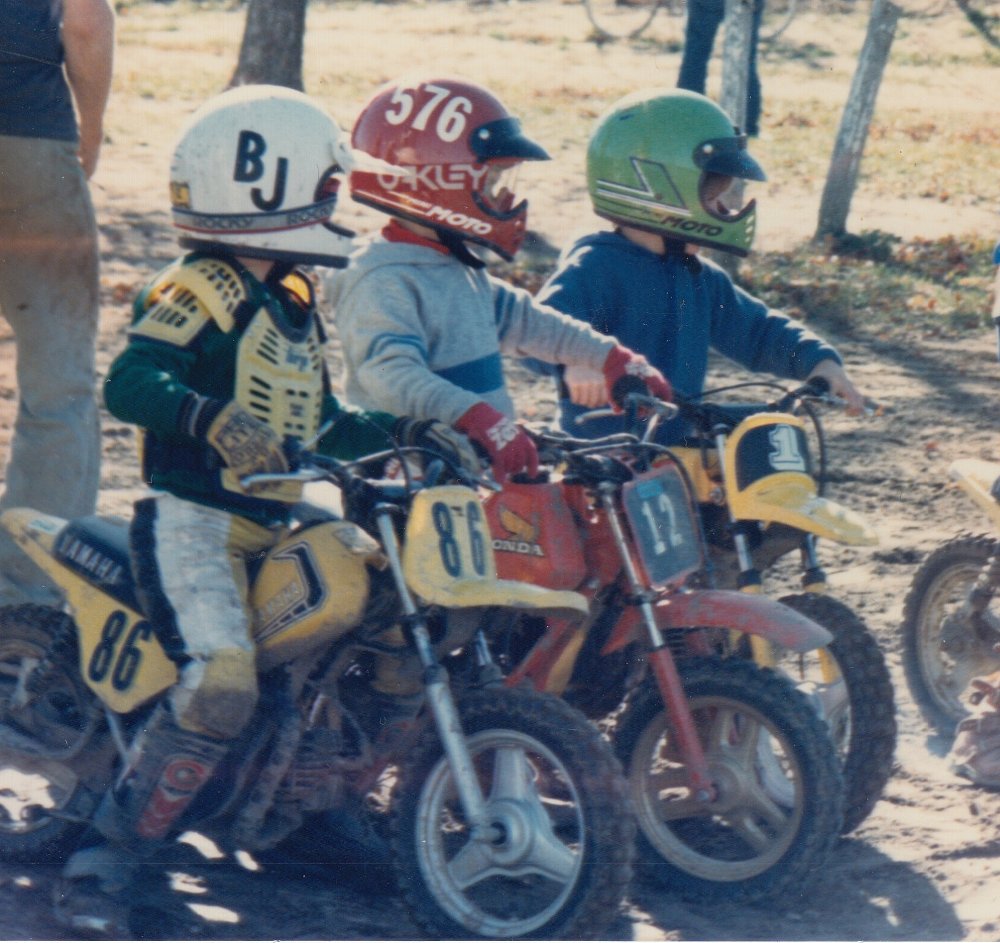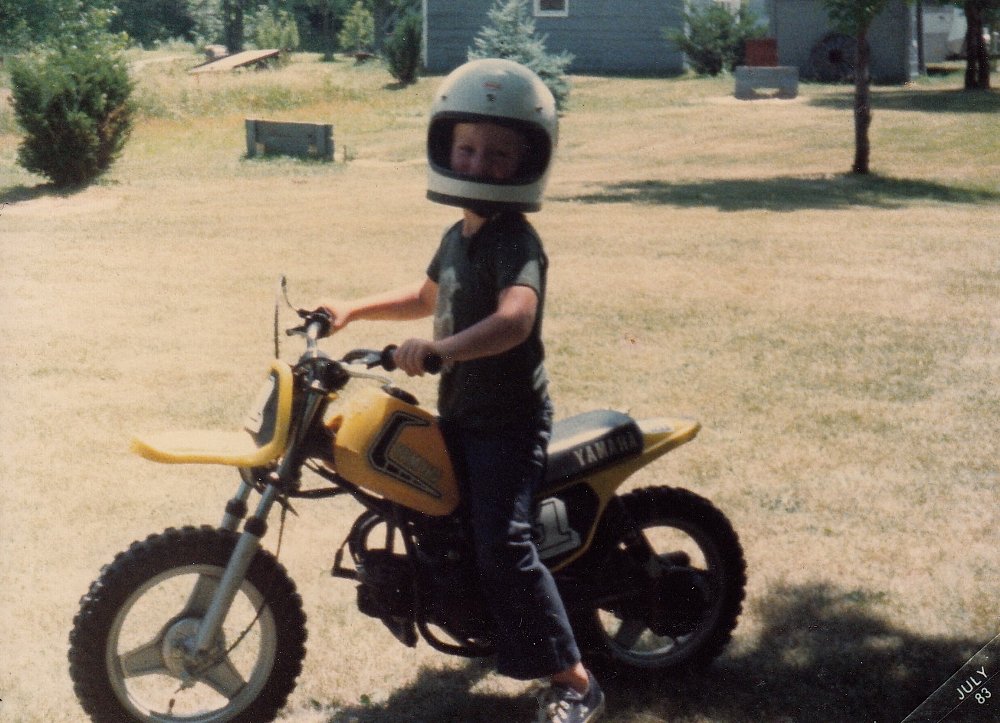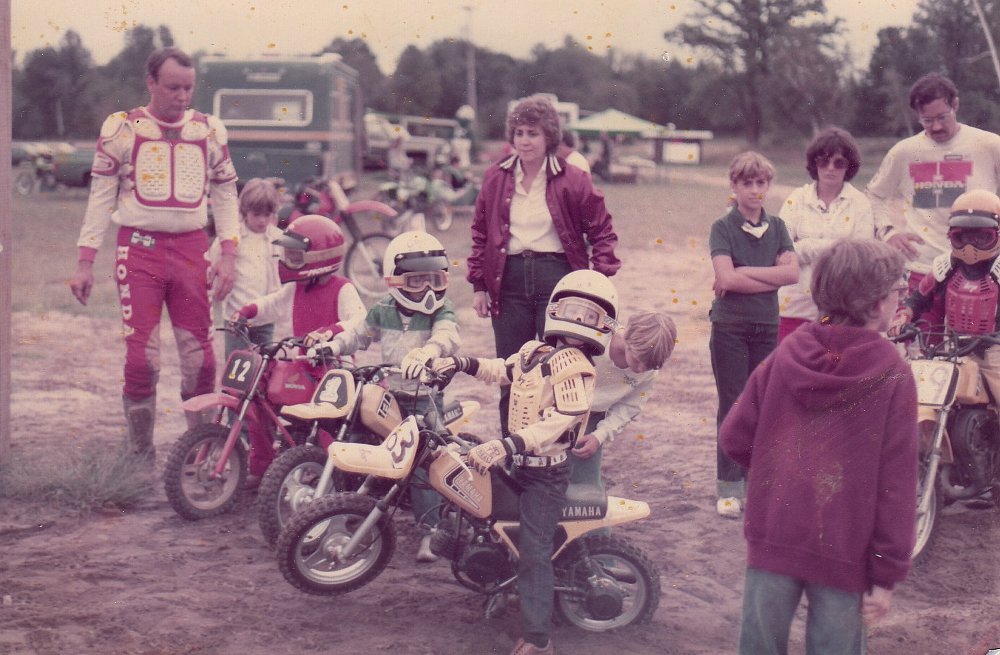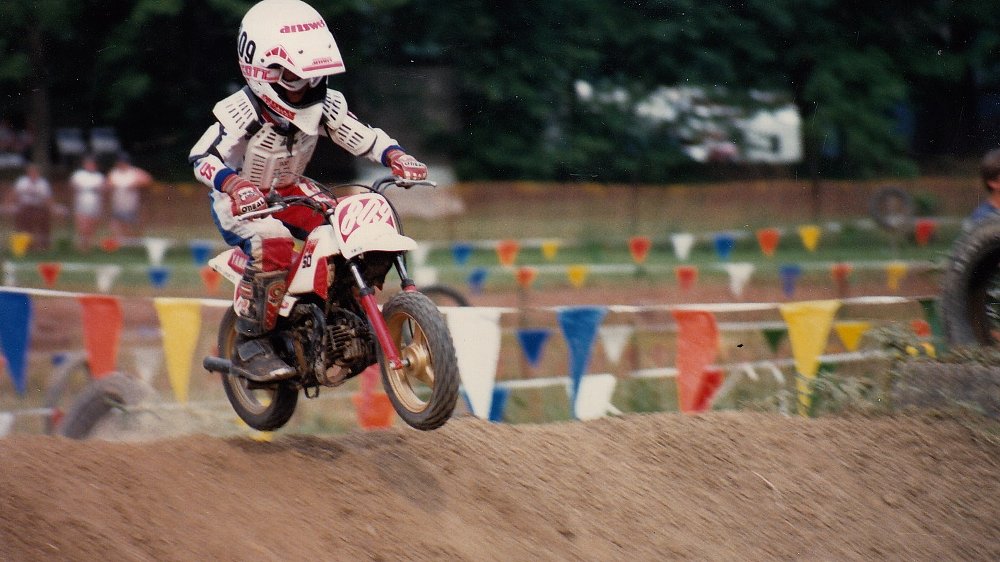My parents married in 1976 and within two years they bought motorcycles. They toured, enjoyed long weekend rides and made new friends with similar interests.
And then I came along.
They tell a story about taking off on their motorcycles but turning around a few miles in because they remembered they had a baby at home asleep in a crib. Now a parent myself, I find that one hard to believe but I’ll go to my grave accepting this urban legend. Their two-wheeled jaunts turned infrequent as my toys replaced their toys.
In 1983, shortly before I turned four, dad and a co-worker were browsing a newspaper while on break, looking through the classifieds and bantering about “what a true Honda Interstate” was. I still don’t know what that means. The co-worker saw a Yamaha Y-Zinger for sale and pointed to the ad.
“This is an introductory motorcycle for little kids, like yours,” he said.
Dad got excited. He had the means to give his kid a better (and earlier) motorcycle introduction than he got. His experiences with motorcycles as a teenager were fleeting. He didn’t get his own until the late 70s, when he bought a 1978 Yamaha 650 Special. Almost everything prior to that was him ogling over the latest ride his cousin Robert bought. Robert was several years older, independent and impossibly cool. My dad, the underfed oldest of six children, was so lanky and scrawny he could slide under a closed door.

Dad's first ride, into the ditch
Dad was 12 or 13 the first time he rode. It was mid-1960s in mid-Michigan on a dirt road somewhere outside of Flint. Robert had just bought a Yamaha 250. He sat on the back while he went over the controls with Dad: throttle, clutch, brakes, kick starter, etc. He probably considered the possibility of the bike taking my dad for a ride instead of the other way around. Remember that scene from “On Any Sunday” when the suburban bike owner let his inexperienced neighbor ride on the front lawn? The noob dumped the clutch, popped a few wheelies, dragged his feet, rode in circles and then wrestled the bike to the ground. There’s truth in that staged scene. It happened all over the world, including on dirt roads in Michigan.
This was at least half a decade before Bruce Brown’s movie came out. With his cousin on the back, Dad dumped the clutch, grabbed more throttle when he should have grabbed less, got squirrely and ran it into the ditch. And then, like something from an episode of Looney Tunes, they chugged up the embankment and back on the road. They didn’t lay it down.
“I was freaking out but I got it back on the road,” Dad says.
The PW50, like a toy
The bike advertised in the newspaper was a 1981 Yamaha PW50, the very first model year of the now iconic motorcycle once nicknamed the Y-Zinger. The PW50 first debuted at a national dealer meeting in the United States in September 1980. It made appearances at that autumn’s European shows and stirred up attention. Motocross Action Magazine called it the “Most innovative production bike of 1981.”
As demand for off-road bikes soared through the 1970s, the manufacturers expanded their product lines to include models the whole family could ride. But something wasn’t quite right at the bottom. The smallest motorcycles, the 50 cc bikes from Italjet, Suzuki and even Yamaha were not "little kid" bikes. The leap from learning to ride a bicycle to the available lineup of 50 cc machines in the late '70s was huge. The nine-horsepower YZ50, released as a new model in 1979, had a 24.5-inch seat height and produced 4.5 foot-pounds of torque at 10,000 rpm. It was a tiny rocket ship.
After releasing the YZ50 to the market, Yamaha aimed even smaller, tamer. Two years later, borrowing molds and parts from various scooters they already had, Yamaha released the PW50. The 2.7-horsepower 49 cc engine put out a tame 2.8 foot-pounds of torque at 4,500 rpm. Its seat height was just 19.1 inches, slightly taller than a bowling pin. It sold for $439.
Dad admits the PW was an impulse buy. It was the middle of winter, I probably wasn’t fully potty-trained and I had a little brother at home who was only a few weeks old. He brought me along to see the bike and said I showed no interest in the motorcycle. Instead, I dove to the carpet of the second-floor apartment and played with the pile of toys I found. Today, we wonder why the bike was for sale in the first place. The seller still had a kid well within the PW age range.

“The bike looked like a toy,” Dad says. That’s exactly what the product developers at Yamaha wanted parents to see: a toy that fit under the Christmas tree, also small enough to conceivably fit down the chimney. It’s not an intimidating looking motorcycle but it also doesn’t look comical or cheap.
Dad bought the bike. He thinks he may have paid $300. It sat in the garage through the rest of winter and the usual slushy, soggy Michigan spring. “I remember people saying, ‘What the hell did you buy a three-year-old a motorcycle for?’” he says. But I proficiently rode my bicycle at age three, a baby-blue, banana-seat bike with high handlebars. I still have scars on my elbows from scraping against the coarse brick of our house.
Remembering his own first motorcycle adventure of going into the ditch, Dad went over all the controls with me in the garage and, with the bike on the center stand, had me practice rolling the throttle on and off.
If you can start it...
Another possible urban legend: “If you can start it, you can ride it.” That’s what Dad told people to explain how his kid learned to ride so young.
Starting a PW50 involves several steps. First, the switch on the handlebars must be set to “start.” Don’t forget to turn on the fuel lever under the seat and be sure to flip the choke on the handlebars. The kick starter is on the left, behind the foot peg. It’s about half the length of the head of a golf putter and flips out, parallel to the ground. Little legs might find it difficult to reach it while sitting on the bike. It’s all designed with safety in mind. Once the bike starts, the thumb switch on the handlebars must be moved from “start” (which is basically neutral) to “run.”
I have a three-year-old now. I can’t imagine her negotiating all that but she’s already trying to figure out how to do a wheelie on a 12-inch pedal bike that has the wheelbase measurements of a die-cast model. And kids seem to get motivated by things they really want. So, this explains how my dad was working in the yard one day and unexpectedly heard the "puh, puh, puh, puh, puh" idling of the motorcycle in the garage. The PW50 sounds like a muffled weedwhacker. It’s not loud and it’s not quiet.
I can recall vague visions of the original owner’s apartment filling with smoke when he started the bike the day we bought it. The tiny 49 cc engine exhumed the pool of pre-mix that dripped from the oil reservoir while sitting idle for weeks, possibly months. But I can’t remember the first time I rode the bike. There are photos, those square snapshots from the 1980s with the month and date stamped in the bottom right corner. I have some that say "JULY 83." I wore a green T-shirt with Yoda screen-printed on the front, blue pants, blue low-top canvas shoes with white rubber toe covers. I had no socks, no gloves and my helmet was a visor-less Bell Star 120 in the color cueball. It took two years to get a visor. Gosh, I wish I still had that helmet.
That day in July 1983 could have been my first time on the bike but it’s impossible to prove. It also could have been the day I jumped that PW50 in ways it wasn’t meant to be jumped. That’s not saying much. The PW50 was not designed to go airborne. The telescopic fork offered 60 mm of wheel travel (that’s 2.3 inches).
Like my father about 20 years earlier, I twisted too hard, went down the hill in the back yard and, when I hit the transition, twisted even harder. This all happened while I looked over at the people who watched me ride. I didn’t see the playground slide in my path. I don’t remember how high I went but I can still see how the slide seemed to come out of nowhere and I feel the moment of impact. I didn’t ride the motorcycle for months. It may have been the following spring. Nobody remembers exactly.
“It was bits and pieces,” Dad says. “We didn’t want to push you.”
We kept that playground set for about another 10 years. The dent in the bottom of the slide had a crease, which rusted and scraped our legs. I saw that dent every day of my life and it (eventually) became a funny memory. I don’t know if this is irony or metaphor, but when my brother and I outgrew the playground, dad tore it down, threw it all in a pile in a straightaway on my motocross track, covered it in dump truck loads of dirt and shaped it into a tabletop. In the end, I successfully jumped the slide, but on a Honda CR80.

Off to the races
No formal plan for racing existed in 1983. Dad didn’t buy the bike with hopes of spending every weekend at District 14 motocross races and then a week every summer in Hurricane Mills, Tennessee, for the AMA Amateur Motocross National Championships at Loretta Lynn’s. Another co-worker raced at a track only five miles north of our house. We went there to watch him ride. We also saw a class called the “Mini Diggers.” It was a mashup of different 50 cc bikes, but most of them were PW50s. Dad asked me if I wanted to try that. I said "Yes."
“But you’d pretty much agree to anything I asked you,” Dad laughs.
I raced for the first time in September 1984 at that same track where we first saw the “Mini Diggers.” I got second place. Two riders signed up to compete. I spent five years on the Yamaha PW50. My last race on it came in August 1987 at Loretta Lynn’s, our second trip there. I was way too big for the bike by then.

For kids like me, who grew up in the 1980s and early '90s, the PW50 was the unanimous first bike. Suzuki made the JR50, but it was somehow slower than the PW. The Honda Z50 was a four-stroke and, therefore, persona non grata. They occasionally showed up at our local track but it was like a draft horse competing against thoroughbreds.
The PW50 turns 40 this fall. It’s the bike that made me. It’s the bike that’s still creating thrills for new riders all over the world.















